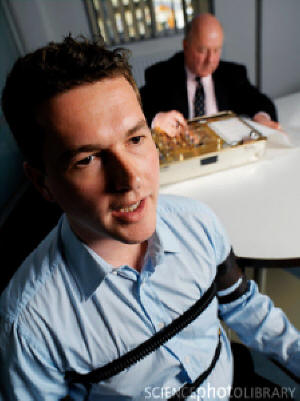Back to Polygraph Information Bibliography for Polygraph Information
 KidZone Science
KidZone Science
Polygraph
Testing
Polygraph testing was invented in order to determine whether a
subject is deceitful or not. Three results can be gathered from the
test: NDI (no deception indicated), DI (deception indicated) or INC
(inconclusive). In order to gather the information required to
affirm or deny a subject’s honesty, the subject must go through a
series of three separate phases, which the tester will administer.
The phases include: the pre-test phase, the in-test phase and the
post-test phase.
Pre-Test Phase
During
the Pre-Test phase the examiner will go through the different
aspects of the polygraph test and how it works, they will answer any
questions the subject may have about the procedures, as well as go
through the questions that will be asked by the examiner. The
examiner will remind the subjects of their rights as a Canadian
citizen and ask them to explain the facts of the situation being
investigated. After all of the questions have been answered, and the
subject is comfortable with their decision, the examiner will attach
the subject to several harmless components. These components
include: a blood pressure cuff, two pneumographs and two
galvanometers.
In-Test Phase
During the in-test phase the
subject is tested for signs of deception or guilt in relation to the
situation under investigation. The number of tests administered by
the examiner will number anywhere from 3 – 6. The tests last for a
total of 5 minutes with a 2 minute rest in between each test. During
the tests the polygraph instrument gathers information about the
subject’s respiratory, cardiovascular and electro dermal activities.
These observations are constantly recorded using a computerized
system, which can later be looked at to identify different shifts in
a subject’s response to the questions.
Post-Test Phase
The examiner will interpret the observations made by the polygraph
instrument in order to determine the results of the test. Once these
have been determined the subject will receive the outcome and have
an opportunity to defend any of their reactions to the questions.